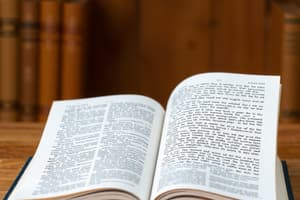Podcast
Questions and Answers
Vulgarisms are rude words or expressions used mostly in speech of the uncultured and ______.
Vulgarisms are rude words or expressions used mostly in speech of the uncultured and ______.
uneducated
Jargonisms are words used within certain social and ______ groups.
Jargonisms are words used within certain social and ______ groups.
professional
Regional dialectisms often include words that are commonly used by ______ in specific regions.
Regional dialectisms often include words that are commonly used by ______ in specific regions.
peasants
The interrelation of denotative and connotative meanings is influenced by the sphere of human ______.
The interrelation of denotative and connotative meanings is influenced by the sphere of human ______.
Linguistic elements in imaginative literature can be ambiguous, having more than one ______.
Linguistic elements in imaginative literature can be ambiguous, having more than one ______.
The obvious plane of a literary work is usually expressed in word ______.
The obvious plane of a literary work is usually expressed in word ______.
Poeticisms and foreign words contribute to the ______ layer of a literary text.
Poeticisms and foreign words contribute to the ______ layer of a literary text.
The implied plane of a literary work can be found in word ______.
The implied plane of a literary work can be found in word ______.
Words of the literary stylistic layer include literary-colloquial and literary-______.
Words of the literary stylistic layer include literary-colloquial and literary-______.
Colloquialisms are words that occupy an intermediate position between literary and non-______ stylistic layers.
Colloquialisms are words that occupy an intermediate position between literary and non-______ stylistic layers.
Poeticisms are words used exclusively in ______; many of them can be considered obsolete.
Poeticisms are words used exclusively in ______; many of them can be considered obsolete.
Foreign words and ______ are not part of the standard vocabulary of a language.
Foreign words and ______ are not part of the standard vocabulary of a language.
Words that are stylistically ______ have a specific stylistic reference tied to their respective sphere.
Words that are stylistically ______ have a specific stylistic reference tied to their respective sphere.
Slang words often originate in everyday speech and exist on the ______ of the lexical system.
Slang words often originate in everyday speech and exist on the ______ of the lexical system.
Professionalism refers to words characteristic of the conversational variant of ______ speech.
Professionalism refers to words characteristic of the conversational variant of ______ speech.
The main opposition in stylistically marked words lies between those of literary and non-literary stylistic ______.
The main opposition in stylistically marked words lies between those of literary and non-literary stylistic ______.
The degree of ______ depends on the genre of the literary work.
The degree of ______ depends on the genre of the literary work.
A ______ detail is selected to represent the whole in poetry.
A ______ detail is selected to represent the whole in poetry.
Analogy and ______ are universal principles of cognition in literature.
Analogy and ______ are universal principles of cognition in literature.
In literature, authors use ______ to creatively convey their messages and emotions.
In literature, authors use ______ to creatively convey their messages and emotions.
The portrayal of characters in ______ helps reveal their emotional states and motivations.
The portrayal of characters in ______ helps reveal their emotional states and motivations.
A ______ is designed to give the text a dynamic flow with recurring elements.
A ______ is designed to give the text a dynamic flow with recurring elements.
The pupils’ behavior in Joyce's description aims to disclose Mrs. Sinico’s ______.
The pupils’ behavior in Joyce's description aims to disclose Mrs. Sinico’s ______.
Colloquialisms and ______ serve to establish the cultural context of a work.
Colloquialisms and ______ serve to establish the cultural context of a work.
Flashcards
Poetic Detail
Poetic Detail
A selected part of a literary work that represents the whole.
Typify
Typify
Represent a general type or category of something from specific items.
Individualize
Individualize
Make someone or something seem uniquely different.
Principle of Analogy and Contrast
Principle of Analogy and Contrast
Signup and view all the flashcards
Recurrence
Recurrence
Signup and view all the flashcards
Literary Work Structure
Literary Work Structure
Signup and view all the flashcards
Leitmotif
Leitmotif
Signup and view all the flashcards
Vulgarisms
Vulgarisms
Signup and view all the flashcards
Jargonisms
Jargonisms
Signup and view all the flashcards
Regional Dialectisms
Regional Dialectisms
Signup and view all the flashcards
Denotation
Denotation
Signup and view all the flashcards
Connotation
Connotation
Signup and view all the flashcards
Literary Text
Literary Text
Signup and view all the flashcards
Verbal Layer
Verbal Layer
Signup and view all the flashcards
Ambiguity in Literature
Ambiguity in Literature
Signup and view all the flashcards
Denotative meaning
Denotative meaning
Signup and view all the flashcards
Connotative Meaning
Connotative Meaning
Signup and view all the flashcards
Functional Styles
Functional Styles
Signup and view all the flashcards
Stylistic Reference
Stylistic Reference
Signup and view all the flashcards
Stylistically Neutral Words
Stylistically Neutral Words
Signup and view all the flashcards
Stylistically Marked Words
Stylistically Marked Words
Signup and view all the flashcards
Literary Stylistic Layer
Literary Stylistic Layer
Signup and view all the flashcards
Literary-Bookish Words
Literary-Bookish Words
Signup and view all the flashcards
Terms (specific)
Terms (specific)
Signup and view all the flashcards
Popular Terms
Popular Terms
Signup and view all the flashcards
Professional Terms
Professional Terms
Signup and view all the flashcards
Poeticisms
Poeticisms
Signup and view all the flashcards
Foreign words / barbarisms
Foreign words / barbarisms
Signup and view all the flashcards
Colloquialisms
Colloquialisms
Signup and view all the flashcards
Slang Words
Slang Words
Signup and view all the flashcards
Professionalisms
Professionalisms
Signup and view all the flashcards
Study Notes
Analytical Reading
- Analytical reading is a language study focusing on verbal art theory and practice
- It improves readers' communication skills, broadens perspectives, and enhances knowledge
- It allows for critical analysis of fiction, leading to greater appreciation of literature
- Aims to help readers understand the literary work, author's intentions and outlook, and author's attitude toward depicted events and characters.
- It explores how linguistic devices (graphical, phonetic, lexical, grammatical) are used to convey the author's purpose, and examines the educational and aesthetic value of the work.
Literary Work
- A literary work is a structured fragment of objective reality, interpreted through the author's perspective
- It aims to understand and interpret the world through a re-creation of reality in the form of images
- Represents a life situation, expressed through an imagined world by the author based on their absorption from objective reality
- Involves a creator (author) and a receiver (reader), creating a communication process.
- The author's attitude in a work isn't necessarily directly perceived by the reader.
- Includes two planes of understanding: meaning (plot, portrayal of reality) and sense (author's implied message)
Language as the Medium of Literature
- Verbal communication is possible because words can denote concrete things and concepts.
- Words have denotative meanings (concrete meanings) and connotative meanings (suggested feelings and ideas)
- Denotative meaning is the dictionary definition, whereas connotation goes beyond the dictionary definition
- Emotive component in words relates to feelings and attitudes, while stylistic reference connects words to specific spheres of society.
- Words can hold stylistic reference, indicating context or social sphere.
- Neutral, literary, literary-colloquial, and literary-bookish styles exist as subdivisions in marked words.
Literary Text as Poetic Structure
- A literary text is constructed from words forming phrases, sentences, and larger sections
- It has a verbal layer (words) and a supraverbal layer (meaning, plot, etc. that emerge from words)
- These layers work together to create a complete poetic structure, conveying the author's complete message.
- Poetic structure includes various components such as narrative voice, theme, idea, and characterization.
Components of Poetic Structure
- Literary image is the way a world is represented in literature. It involves macro (the work itself) and micro (words) elements.
- Characterization: The way characters are represented in literature. Direct (explicitly stated) and indirect (through actions) characterization are used.
- Theme and Idea: The central topic and underlying message of a literary work.
- Plot: The sequence of events in a literary narrative. Internal and external conflicts exist in a story.
- Composition: How plot elements are structured and arranged. Different narrative structures are used in writing.
Studying That Suits You
Use AI to generate personalized quizzes and flashcards to suit your learning preferences.




